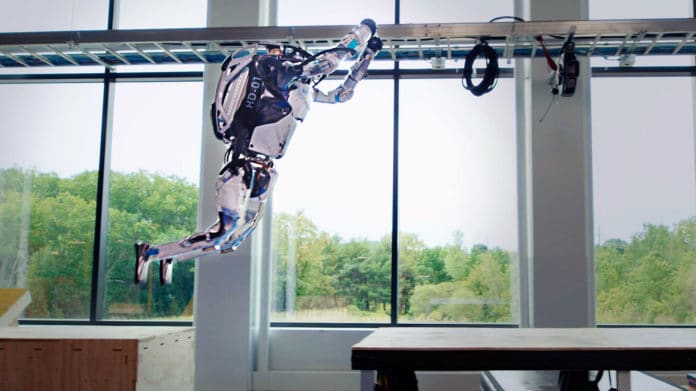Boston Dynamics published a new video of its famous Atlas robot performing the most complex parkour routine seen to date. The new video shows a pair of Atlas robots successfully completing a parkour routine in an obstacle course for the first time.
From dancing to taking a jog through the woods, the rapid evolution of the Boston Dynamics’ Atlas robot has been incredible over the past few years. However, unlike previous videos that focused on single acrobatic movements, this new video demonstrates the robots’ ability to navigate a variety of dynamic challenges.
The pair of Atlas machines ran up a series of banked plywood panels, broad jumped a gap, and ran up and downstairs in the course set up on the second floor of the Boston Dynamics headquarters. They leapt gaps, vaulted beams, and even coordinated a backflip, all without missing a beat.
The Hyundai-owned firm noted that it took months of fine-tuning to develop this routine for robots. The routine served as a useful test of the robots’ ability to maintain their balance while switching behaviors and coordinating actions.
As narrow and specific as it may seem, Parkour gives the Atlas team a perfect sandbox to experiment with new behaviors. It’s a whole-body activity that requires Atlas to maintain its balance in different situations and seamlessly switch between one behavior and another.
“It’s really about creating behaviors at the limits of the robot’s capabilities and getting them all to work together in a flexible control system,” says Scott Kuindersma, the Atlas team lead at Boston Dynamics. “There are many important problems that parkour doesn’t force you to address, but that’s not the point. We’re not trying to solve everything all at once. The work we’re doing now is allowing us to create a solid foundation for tackling the next set of research problems.“
In addition to the videos, the company explains a little of Atlas’ evolution over the years. According to its creators, in its first versions, the robot was essentially blind and depended entirely on programmed commands to move. This new version, however, relies more on your own perception to navigate, which means it’s less pre-programmed than before.
The company still has to refine movements that are limited by the very nature of the robots themselves. Also, Atlas is not a production robot like Spot. It is still fundamentally a research and development model meant to push the limits of robotics, and there is no current indication Atlas is being built for direct commercial outcomes. Recently, Boston Dynamics has presented Stretch, a robot developed explicitly for warehouse work.
